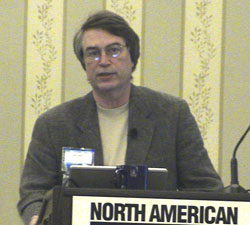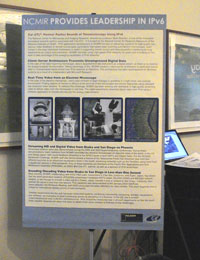Larry Smarr Says Science Applications Driving IPv6 Adoption
June 25, 2004 -- In a presentation to the IPv6 North American Summit last week, Calit² director Larry Smarr said data-intensive e-science, requiring common cross-agency cyberinfrastructure, is helping drive adoption of IPv6 across universities, industry, and the government.
"But the technology folks are not partnering with driving science projects as early as they might," said Smarr. "This is a missed opportunity for faster development as many ambitious science projects require the most modern telecom and IT to work."
Smarr pointed to the leadership provided by the European Union: "The EU has had a clear vision for years in terms of how e-science and e-business work together. They are creating an application-neutral einfrastructure driven by large science experiments that looks ahead to the needs of e-science, e-health, e-learning, and e-business. These domains have comparable requirements for security and bandwidth." As an example, Smarr cited the EU's DataGrid project and its 6net Large-Scale International IPv6 Pilot Network.
Smarr compared the development of cyberinfrastructure, still early in its evolution, with that of the power grid. "You'll notice there's not an electrical system for science and a separate one for business," he said. "What we're doing is constructing a global knowledge infrastructure. Right now we're at the stage of 1,000 flowers blooming. It's a competitive period, but standards will emerge that will enable us to do things vastly beyond what's possible today and transform the globe."
But e-science global cyberinfrastructure must be IPv6-compatible. Quoting Vinton G. Cerf, a new member of the Calit² Advisory Board, Smarr said, "'The value of IPv6 can be realized only if deployment is based on a global scale.'" Scientists may understand the benefits of IPv6 as a global standard more than the fractionated world of business, suggested Smarr.
The United States' responses to implementing IPv6 have varied widely. DOD, as they did in the early days of creating the Internet, moved forward aggressively and, in fact, at last year's IPv6 summit, mandated enterprise-wide deployment of IPv6.
DOE has shown similar ambition to support ESnet, its Energy Sciences Network. Other agencies, however, have not been so forward-looking, said Smarr.
"It can be embarrassing to be an American next door to an advanced country like Canada," said Smarr. "Canada's Ca*net has been a pioneer in using dedicated optical nets. It's based on native IPv6."
|
The kinds of large science projects that are driving implementation of IPv6 include the Large Hadron Collider (LHC) at CERN. Smarr reminded attendees that it was this very lab, and Tim Berners-Lee in particular, that developed the protocols for the Web (such as HTML and HTTP) to make it possible to publish scientific publications. "Except possibly for NASA activities, the LHC is as big as science gets on earth," said Smarr. "This is the planet's particle accelerator."
Unfortunately, with the collapse of the SuperCollider project, the US dropped out of building ever-more-powerful particle accelerators. "We couldn't stay in the race," said Smarr, "so, in the future, American scientists will have to go all the way to Geneva to achieve breakthroughs in fundamental physics." The LHC will be creating tens of petabytes of data that are going to need to be shared across tens of thousands of users.
Various organizations collaborating with CERN have shown the importance of IPv6 to this endeavor. In one demonstration, led by Caltech's Harvey Newman, a TCP/IPv6 single stream land speed record was achieved from Caltech to Geneva, transferring 4 Gbps sustained over 20 minutes, totaling some 560 GBytes over 11,539 kilometers. "This is an excellent example of a really demanding science driver," said Smarr.
"If you're scientist in the US and want to use the world's best equipment," said Smarr, "you need to use the net not only to receive data but drive the instrument." Citing work by Mark Ellisman, a professor in the UCSD School of Medicine, Smarr described a KDDI demonstration that streamed full digital video generated by the world's most powerful medical electron microscope and HDTV between Osaka, Japan, and San Diego, California.
"We were able to sit and move a computer mouse in San Diego and see a live image on the screen from the microscope in Japan. From a human point of view, there was no latency. It was like you were in the same room with the microscope accompanied by an HDTV stream of colleagues in Japan that enabled interacting with them." Ellisman's lab is the National Center for Microscopy and Imaging Research funded by the National Center for Research Resources at NIH.
Given the need for multi-Gbps data streams in science, how do we get them through the shared Internet? In spite of the fact that the backbone Internet2's capacity is 10 Gbps, the practical ceiling on bandwidth is about 30-100 Mbps, according to NASA measurements.
The needed capability, in fact, will become a "utility" at the end of this year via the National Lambda Rail. "This national optical network," said Smarr, "will enable dedicated lambdas that are totally predictable and have no jitter. It will be allocated to scientists for specific uses. It's an extreme approach to guaranteed quality of service."
|
Still Smarr reminded attendees that the US is behind, compared with work going on in many other countries. In an effort to catch up, representatives from the US teamed with colleagues in Europe last summer in Iceland to create the Global Lambda Integrated Facility or GLIF (www.glif.is), which is now routinely running experiments at 20 Gbps between Amsterdam and the National Science Foundation-funded StarLight facility in Chicago.
The NSF is also interested in investigating the capabilities of such a deterministic network. Through its Information Technology Research program, it has funded the $13.5M "OptIPuter" project. Using reliable blast UDP, the OptIPuter has demonstrated 95% utilization of 10-Gbps, national-scale optical paths, compared with <1% with the commodity Internet.
As advisor to the NASA Administrator on IT and telecommunications, Smarr recently oversaw delivery of a report that recognizes that NASA doesn't have much deployed IPv6. The report recommends that NASA commit to the transition, much as the DOD has, as soon as possible.
In fact, NASA has already made recent headway on this by joining the OptIPuter project and working to link the Goddard Space Flight Center in Maryland to the Scripps Institution of Oceanography at UCSD. "Level 3 is planning on providing dedicated gigabit by next month to jump start the National Lambda Rail," said Smarr. In this project, Calient, Glimmerglass, and Lucent are experimenting with advanced optical technologies to see how they operate in a real-world setting.
Future possible OptIPuter drivers include data supplied by gigabit fibers being established on the ocean floor. NSF is about to spend $200M to develop the next generation of ocean fiber-optic infrastructure, taking telecom cables as they're being abandoned and modernizing them to support distributed ocean observatories in the Ocean Research Interactive Observatories Network (ORION) project.
"This will make it possible to position stereo high-definition cameras on hydrothermal vents 24 by 7," said Smarr, who, as an early taste of what this data might look like, pointed attendees toward the stereo movie Extreme Life, being directed by James Cameron, which is set to debut in theaters soon. "If we can get this infrastructure to be born IPv6, it can act as an accelerator of technological change," he said.



